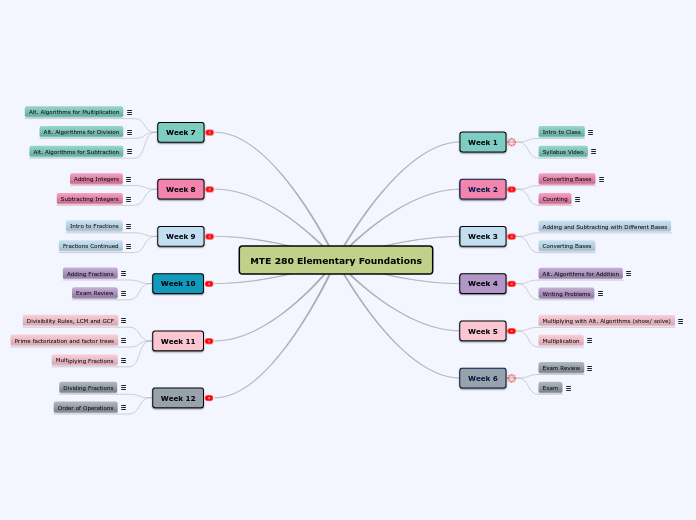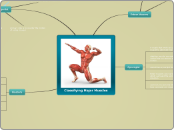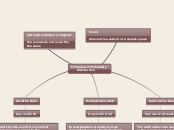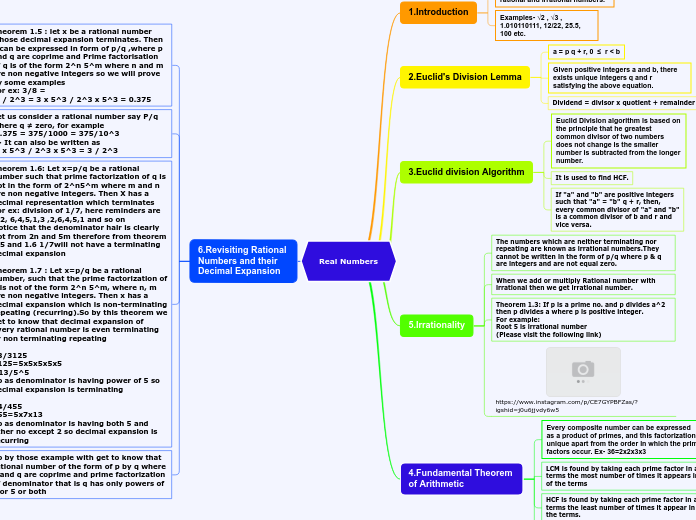MTE 280 Elementary Foundations
Week 12
Order of Operations
Dividing Fractions
Dividing Fractions
when dividing fractions, always KCF (keep, change, flip)
- also remember to use the funky 1's as seen in multiplying fractions to reduce to limit mistakes
example: 3and3/5 divided by 1and2/10
- first convert numbers to a mixed numbers to get 18/5 and 12/10
- then find out the multiples
- 18 = 3x6
- 10 = 2x5
- 12 = 6x2
- the two 6's and two 5's cancel out so you're left with 6/2 which = 3
remember: when converting to mixed number, use "backwards c"
Week 11
Multiplying Fractions
Multiplying Fractions:
No different than normal multiplication
Example: (3/4)(2/3)=6/12=1/2
Makes the problem much more simple and less prone to simple math mistakes if you try to reduce/ simplify the fractions before multiplying
Example: (24/35)(21/40)
can be simplified by doing the funky "1s" example from class
24=6x4 and 40=4x10 so the 4's can be crossed out
35=5x7 and 21=7x3 so the 7's can be crossed out
then you're left with (6/5)(3/10)=18/50=9/25
Prime factorization and factor trees
Prime Factorization: finding which prime numbers multiple together to make the original number
Example:
90
9 10
3 3 5 2
so... the prime factors= 2x3x3x5
Divisibility Rules, LCM and GCF
Divisibility Rules
2: even #s
3: sum of digits divide by 3
4: last 2 digits divide by 4
5: any # ending in 5 or 0
6: even and sum of digits divide by 3
8: last 3 digits divide by 8
9: sum of digits divide by 9
10: any # ending in 0
Least common multiple
- bigger number and shared multiples
- find prime factorization then multiply the prime factors together
Greatest common factor
- what the two prime number groups share then multiply
- smaller number
Example: GCF and LCM of 60 and 45
- prime factorization for 60=2^2, 3, 5
- prime factorization for 45=3^2, 5
so...
- LCM=3x5=15
- GCF=2^2x3^2x5=180
Week 10
Adding Fractions
Adding Fractions
Tip: if you're given 5+3/8, all you have to do is add it, not convert 5 into a fraction
- 5and3/7 + 4and1/7 goes to be 5+4 then 3/7+1/7 because they have the same denominator
25-4and3/16 is more complicated
- 25-4=21 but then you have to take 1 out and make it a fraction
- so then you have 20and16/16-3/16
- then you get 20and13/16
What fractions mean:
3(5) = 3 groups of 5
3(2/7) = 3 groups of 2/7
(1/3)12 = one shirt of a group of 12
Week 9
Fractions Continued
More Fractions
Important tip:
- the fractions have to be equal to add them correctly, but not to multiple or divide
Ways to show fractions example: 4/6
set model: xxxx~~
area model: [] [] [] [] [] []
linear model: -+-+-+-
-+-+-+-+-+
Intro to Fractions
Intro to Fractions
which fraction is larger?
4/7 or 5/7
- whichever fraction in closer to "1" is larger
- think of it like pieces of a pie
5/7 pieces is more than 4/7 because it is closer to 1
5/8 or 5/9
- 5 out of 8 pieces of pie is more then 5 out of 9 pieces of pie
Easy tip: when doing a problem like 32+8/11
it equals 32and8/11 so don't make it more complicated
numerator= # of pieces
denominator= size of pieces
Week 8
Subtracting Integers
Subtracting Integers
KEEP, CHANGE, CHANGE
Show:
-5-(-2) = - - - - - take away 2 = -3
-4-2 = - - - - - -
take away 2 ++ = -6
Making zeros: a - and a + go together to create a "zero"
Solve:
-35-(-15)
K C C = -35 + 15 = -20
(use Mr. Kilt's student's algorithm shown in adding integers)
5-9
+ -- so it's going to be a negative number = -4
Adding Integers
Adding Integers
Tip: when talking to students about whether the positive or negative number is bigger...
- not "which is bigger" should be "which one would have a bigger tile pile"
Example: 3+(-5)
- 3 is the "bigger" number because it is positive, but for our purposes -5 is actually bigger because it would have the bigger pile of red tiles then 3
SHOW: 3+(-5) Mr. Milt's student's algorithm
+++
_ _ _ _ _ = -2
(there is a bigger pile of negatives, so the answer must be negative)
SLOLVE: 24+(-35)
24 + (-35) = -9
+ - - so...it will end up being a negative number
Week 7
Alt. Algorithms for Subtraction
Alt. Algorithms for Subtraction
Subtraction = the distance between two numbers
show using longs and units
24-12 will go to be two longs and 4 units...then you'll take away one long and 2 units to find the answer
24-18
34-28 =6 the same distance between 2 #
33-27
show using tiles
show 5 using 9 tiles
+++++++
_ _
show 5+(-4)
+++++
_ _ _ _ = 1
show -3(-2)
_ _ _ _ _ = -5
Alt. Algorithms for Division
Alt. Algorithms for Division
Tips:
- don't say "divided by", say "goes into"
- spend the first day of lessons showing students simply how to set up problems
- doing multiples that students already know and are comfortable with is the best way to start
Repeated Subtraction
Example: 146/8
- see notes for how to set up
- start by slowly subtracting multiples of 8 and that will go off to the side
- it allows students to practice their multiples
- has a margin for error, but is a good way to introduce division
eventually you'll take 8 away a certain amount of times until you find the answer
Alt. Algorithms for Multiplication
Alt. Algoritms for Multiplication
Multiplication = Area
Area/base 10 block expanded form
example: 27(36)
20+7
30+6
------- then you multiple each number by its vertical and diagonal counterpart
= 600+210
=120+42 then add them all together
Array Multiplication
Example: 3(4)
o o o o
o o o o
o o o o =12
Lattice Multiplication
Example: 25(15)
- see notes for set up
- create box with lattice lines then multiple each box
- after than add the lattice lines (diagonally) then you'll get your answer
= 375
Week 6
Exam
81/82 on exam 1
Exam Review
see notes
Week 5
Multiplication
Multiplication
1st number: # of groups
2nd number: what is inside the groups
What order to teach times tables in:
teach first:
1s
2s
10s
5s
Teach second:
3s
4s
9s
Teach 3rd:
everything else
MULTIPLICATION = AREA OF A RECTANGLE
showing using base 10 blocks:
- draw a square for 10x10
- add sections and lines for each additional unit
example: 14(12)
have a 10x10 flat then have 4 units added on one side and 2 on the other than add everything to get the answer = 168
Multiplying with Alt. Algorithms (show/ solve)
Introduction to Alt. Algorithms for Multiplication
Area Model:
- somewhat like expanded form addition
Example:
24(28)
20 + 8
20
+
4
- multiple each number by its boxed counterpart (20x20 and 20x4, 20x8 and 4x8)
- then add each row to get the answer
this helps reinforce place value and multiplying with numbers ending in 0
Week 4
Writing Problems
How to Write Problems
Show:
convert from base ten to other bases
convert from other bases to base 10
Solve:
convert from base ten to other bases
convert from other bases to base ten
Alt. Algorithms for Addition
Alt. Algorithms for Addition
Friendly numbers:
- adding/subtracting to make both numbers end in zero
example: 28+62 --- 30+60 = 90
Trade off:
- adding/subtracting to make one number end in zero
example: 46+25 --- 50+21 = 71
Left to right:
- adding from left to right instead of right to left
- reinforces place value
example: 37+42 --- add do 30+40 then add the 7 and 2 = 79
Expanded form:
- expanding each number so they're multiples of 10
- reinforces place value
example: 748+165 --- 700+40+8 +100+60+5 = 913
Scratch:
- scratch when numbers make up the base
- add remainders then carry to the next column
- helps students add multiple numbers without having to keep track of everything in their heads
example: 34+12+15
you would scratch when the ones place adds up to 10 then carry over
Week 3
Adding and Subtracting with Different Bases
Week 2
Counting
Counting
Counting and how to works in different bases
- practice the bizz/buzz game to practice how to count
- helps with counting in different bases
Basic counting tools
One to one correspondence
- difficult for younger students to start to comprehend
- it is easy for children to count from 1-10, but they don't know what that means and how it is represented
- practice one-to-one counting to get this idea in their head
Converting Bases
Converting Bases
Diagrams
- using longs and units to represent numbers
- one long equals whatever base you're in
- if there are the number of long that equal what base you're in, it turns into a flat
- flats = 100
Examples:
24six --- 2 long and 4 units
each long = 6 and each unit = 1
so...6+6+4=16
13 to base eight --- 1 long and 3 units
each long = 10 and each unit = 3
so...13 will make 1 long and 5 units = 15
Week 1
Syllabus Video
Class expectations and grading
(see syllabus in canvas)
Intro to Class
Juggling Mr. Milt









